The great British paradox: we spend all winter dreaming of long summer evenings in the garden, then when summer finally arrives, we discover it rains just as frequently but at slightly higher temperatures. I can’t count the number of meticulously planned garden parties I’ve attended where guests huddle under hastily erected gazebos or crowd into conservatories, watching water pool on abandoned patio furniture while the hosts repeatedly assure everyone it will “clear up any minute now.”
Our collective optimism about outdoor living in this distinctly damp climate has always struck me as charmingly delusional. We install fire pits in gardens that see maybe three genuinely cold, clear evenings annually. We invest in expensive rattan furniture that spends 90% of its life under protective covers. We create beautiful patio spaces that remain functionally unusable for most of the year due to our persistently unpredictable weather patterns.
This national triumph of hope over meteorological experience reached its zenith during lockdown, when previously neglected gardens suddenly became essential extensions of our living space. The subsequent explosion in outdoor furniture sales, patio heater shortages, and increasingly elaborate garden structures reflected not just pandemic adaptation but our enduring belief that this time, somehow, we might bend the British climate to our will.
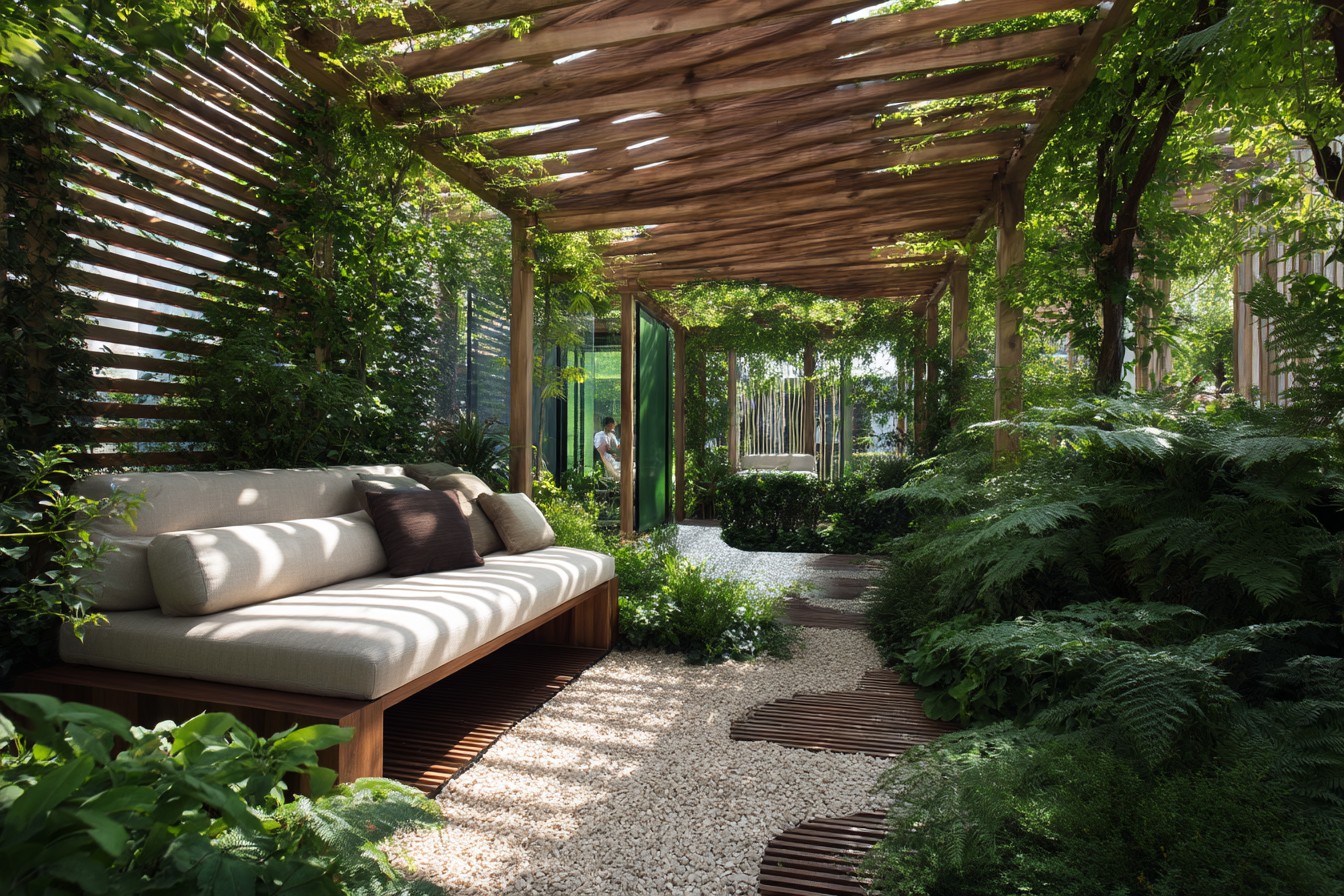
Our own garden journey followed this familiar trajectory. When Charlotte and I bought our current home, the rear garden featured a modest concrete patio, cracked and uneven, that collected water in numerous depressions after even moderate rainfall. During our first summer, we made valiant efforts to use this unpromising space – hosting optimistic barbecues interrupted by sudden downpours, attempting morning coffee during brief dry spells, even dragging out blankets for evening drinks during rare clear nights. The reality, however, was that our actual usage amounted to perhaps twenty days annually – a poor return on valuable urban real estate.
The transformation began with acceptance rather than denial. Instead of pretending we lived in the South of France, we acknowledged the realities of Manchester’s climate and designed accordingly. Our approach focused on creating genuinely usable outdoor space regardless of weather conditions rather than perfect fair-weather areas rendered useless by typical British meteorology. This pragmatic philosophy has since informed dozens of client projects facing similar challenges across various UK locations and garden types.
The foundation for all-weather patio success lies in proper drainage – perhaps the least glamorous yet most essential element of functional outdoor space in our climate. The standard approach of minimal falls toward garden beds proves thoroughly inadequate for the volume and frequency of precipitation many regions experience. Our solution involved more aggressive contouring than typically recommended, with falls of approximately 1:40 rather than the standard 1:60, creating more noticeable but significantly more effective water clearance during heavy rain.
This drainage strategy extended beyond mere surface contouring to include appropriate sub-base construction with clear water paths to designated drainage points. For our relatively modest patio, this meant excavating to greater depth than standard practice, installing substantial sub-base material with integrated drainage channels, and connecting to specific collection points rather than allowing general percolation into surrounding soil. This investment in invisible infrastructure dramatically outweighed the cost of visible surfaces yet determined whether those surfaces would remain usable after typical rainfall.
Material selection for all-weather patios deserves particularly careful consideration beyond aesthetic preferences. Many popular paving options that perform adequately in drier regions or occasional rain become actively problematic in consistently damp conditions. Our initial preference for natural stone was modified after honest assessment of its performance characteristics in Manchester’s climate, where certain varieties develop slippery organic growth that makes them genuinely hazardous during the frequent wet periods.
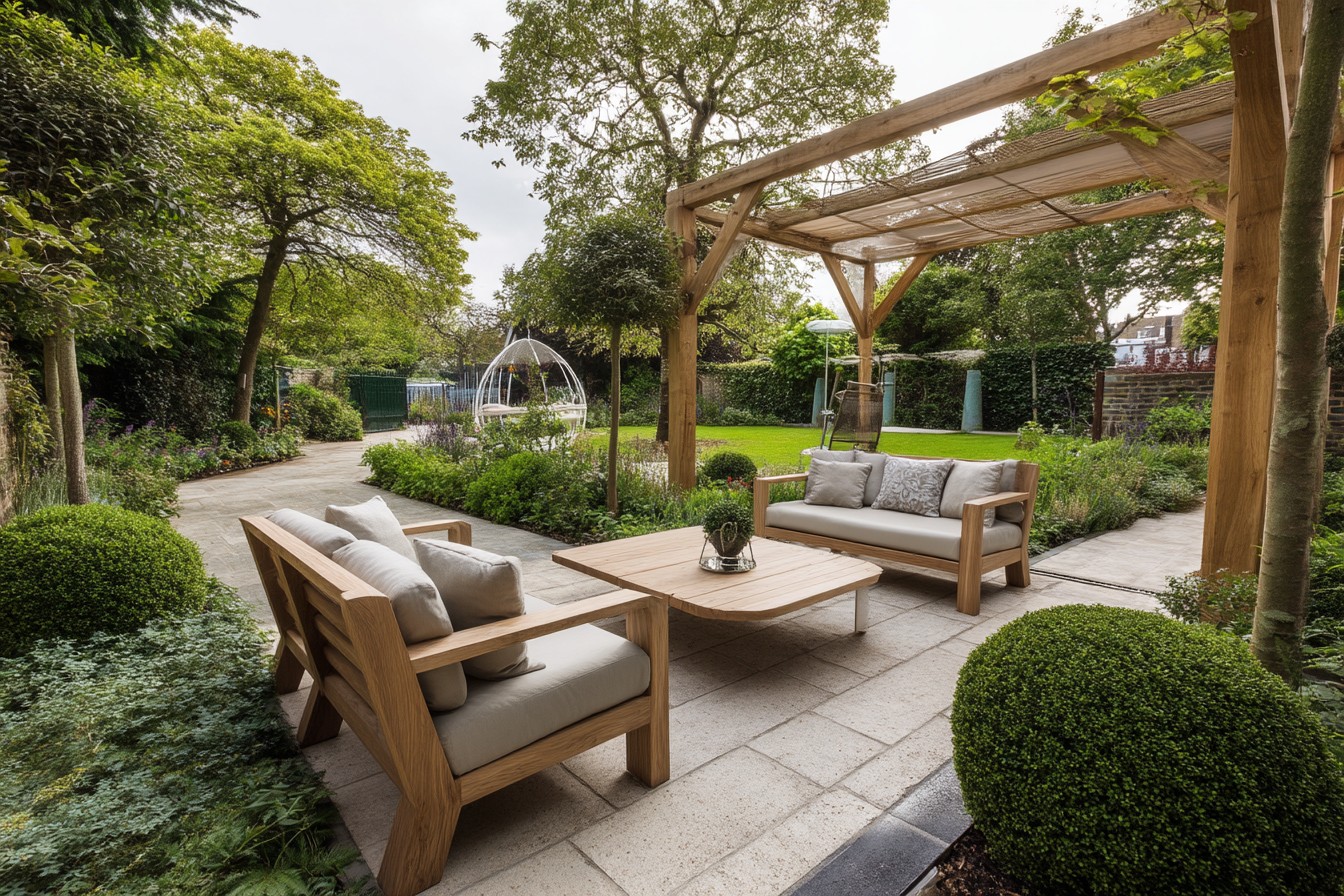
For our main patio areas, we eventually selected porcelain paving with texturing specifically designed for external use – not the dangerously smooth domestic tiles that feature in too many garden accidents, but proper outdoor-rated surfaces with appropriate slip resistance even when wet. The marginal additional cost compared to mid-range natural stone delivered significantly better year-round performance, particularly for areas intended for dining where food spills on natural stone could create permanent staining requiring regular specialist cleaning.
The most transformative element for genuine all-weather functionality was overhead protection – not the temporary gazebos that feature in so many summer gatherings but proper architectural elements designed for permanent weather mitigation. After exploring numerous options from traditional pergolas to contemporary canopies, we selected a hybrid solution combining partial solid coverage with areas of more filtered protection, creating varied environments suitable for different conditions.
The primary dining zone received a permanent structure with a modern polycarbonate roof system that provides complete rain protection while transmitting approximately 70% of available light. This material choice avoided the cave-like effect of solid roofing while delivering genuine weather protection beyond what traditional pergolas with climbers or fabric could achieve. The slight blue tint in the selected polycarbonate prevents the space overheating during rare sunny periods while creating pleasantly diffused light beneath.
This overhead protection was carefully sized and positioned based on prevailing weather patterns rather than arbitrary aesthetic decisions. By analyzing typical rain angles and wind directions, we determined optimal overhang dimensions that prevent precipitation reaching the main seating area without creating unnecessarily massive structures. This analysis proved particularly valuable during recent years of increasingly intense but brief rainstorms, where driving rain at substantial angles renders inadequate coverage effectively useless.
Vertical protection represents another critical element frequently overlooked in British patio design. While overhead coverage prevents direct rainfall, many outdoor spaces remain unusable during typical weather due to wind-driven rain or simply uncomfortable air movement. Our solution incorporated adjustable side panels – not full enclosure that would essentially create a conservatory, but strategic vertical elements that can be deployed or retracted as conditions demand.

These side protections include both fixed elements – a decorative slatted screen on the most exposed boundary that reduces wind penetration while maintaining views and light – and adjustable canvas panels that can be extended during particularly challenging conditions. The combination provides remarkable versatility across different weather scenarios without creating the permanent enclosure that would defeat the purpose of outdoor living. During calmer days, the space feels open and garden-connected; during typical British mixed conditions, it remains comfortably protected without feeling enclosed.
Heating integration transforms usability beyond merely staying dry, particularly during shoulder seasons when evenings might be precipitation-free but temperatures drop rapidly after sunset. Rather than relying solely on those notoriously inefficient freestanding patio heaters, we incorporated more targeted solutions specifically designed for partially enclosed outdoor spaces. Wall-mounted infrared heaters provide directional warmth exactly where needed without attempting to heat the entire sky above, while a small integrated firepit offers both practical warmth and psychological comfort during cooler evenings.
This heating approach acknowledges the realities of outdoor physics rather than fighting against them. Instead of creating uniform ambient warmth impossible in open air, it focuses on heating people and surfaces directly through radiation principles. The result delivers genuine comfort in temperatures down to about 10-12°C without unreasonable energy consumption or environmental impact. Below those temperatures, we’ve found that even the best-designed outdoor spaces become less appealing regardless of heating provision – British weather occasionally wins despite our best efforts.
Lighting design dramatically extends usability hours beyond natural daylight, particularly crucial during winter months when darkness arrives by mid-afternoon. Our integrated scheme includes both practical task lighting for dining and cooking areas and more atmospheric options that enhance enjoyment during evening use. The system operates on separate circuits allowing different configurations depending on activities and desired ambiance, with all fittings specified for proper external rating appropriate to their specific positions – fully exposed, partially covered, or completely protected.
This layered lighting approach transforms the psychological experience of outdoor spaces after dark, creating welcoming environments rather than the gloomy, poorly-illuminated areas that discourage winter use. Careful placement avoids both inadequate lighting that feels uncomfortably dark and over-illumination that creates harsh, exposing brightness. The balance proves particularly important in urban settings where light pollution considerations must be balanced against practical functionality.
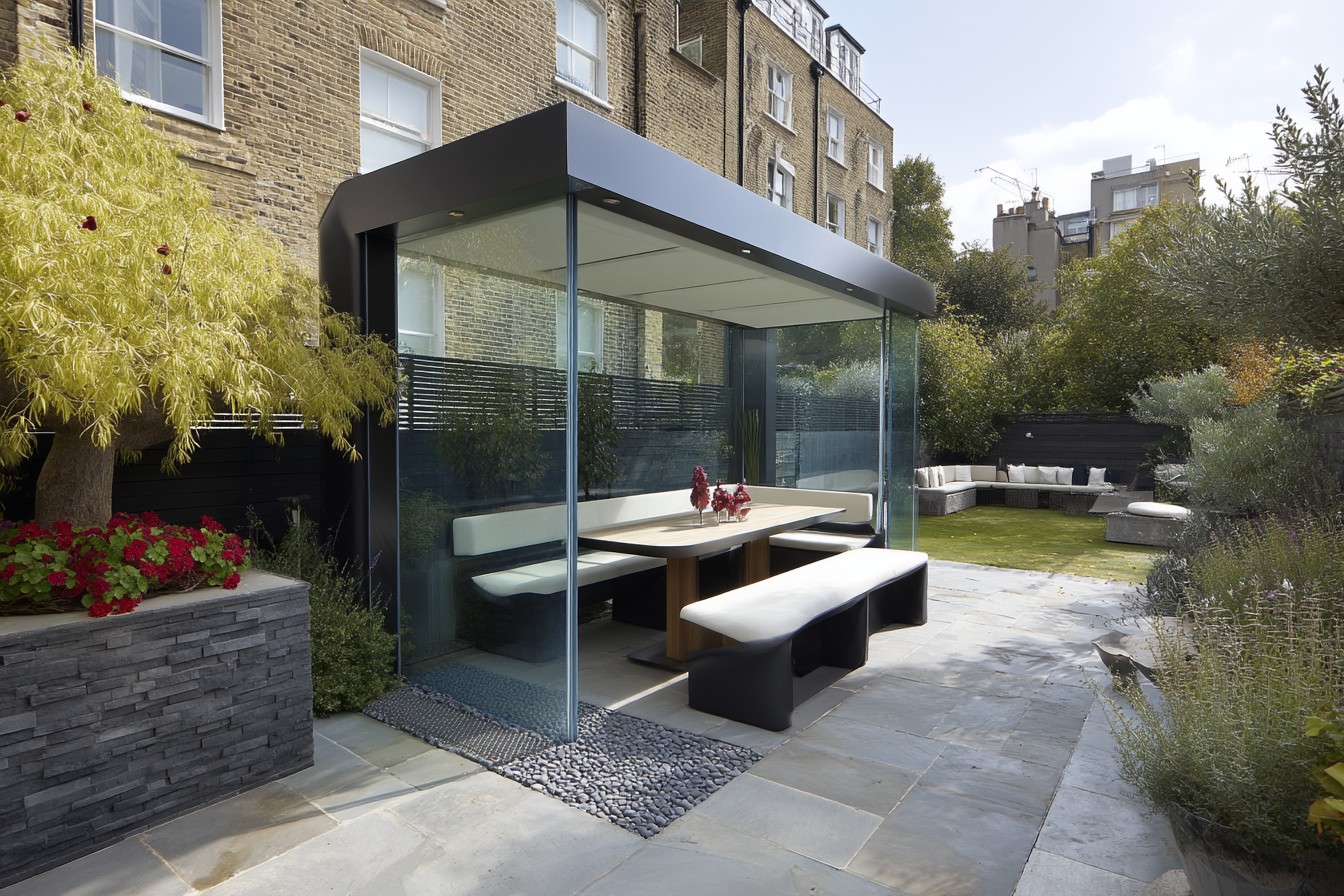
Furniture selection for genuinely all-weather use demands reconsideration of conventional garden options, most of which perform poorly in consistently damp conditions despite marketing claims. After disappointing experiences with traditional rattan sets that deteriorated rapidly despite manufacturer promises, we adopted a hybrid approach combining different materials appropriate to their specific exposure levels and usage patterns.
For fully covered dining areas, we selected furniture that bridges indoor-outdoor classifications – substantial pieces with proper comfort for extended use but materials selected for humidity resistance rather than full weather exposure. In partially protected areas, properly specified marine-grade materials provide significantly better performance than standard outdoor ranges, with appropriate maintenance schedules factored into selection decisions. This graduated approach delivers appropriate durability without requiring entire gardens filled with aggressively weather-resistant pieces that typically compromise on comfort and aesthetics.
Flooring transitions between indoor and outdoor spaces significantly impact all-weather functionality beyond mere aesthetics. Traditional substantial thresholds and level changes between house and garden create psychological as well as physical barriers to outdoor use during marginal weather. Our approach minimized these transitions through careful level planning and threshold design, creating near-seamless movement between inside and out that encourages spontaneous garden use even during brief favorable windows.
For clients undertaking more substantial renovations, we often recommend floor material continuity between indoor and outdoor spaces, with appropriate variations for different performance requirements. Using visually similar materials with different technical specifications – porcelain tiles with different texturing, for example – creates visual connection while maintaining proper functionality for each environment. This continuity substantially changes how outdoor spaces are perceived and used, transforming them from separate garden elements to genuine living space extensions.
Storage integration within all-weather patio designs frequently receives insufficient attention despite its impact on year-round functionality. Effective outdoor spaces require accessible storage for items that enable comfort in variable conditions – additional blankets for temperature drops, cushions for occasional use, candles for evening ambiance, even board games or entertainment for longer gatherings. Without convenient storage, these elements either remain permanently exposed to weather deterioration or require cumbersome transport from indoor storage before each use.
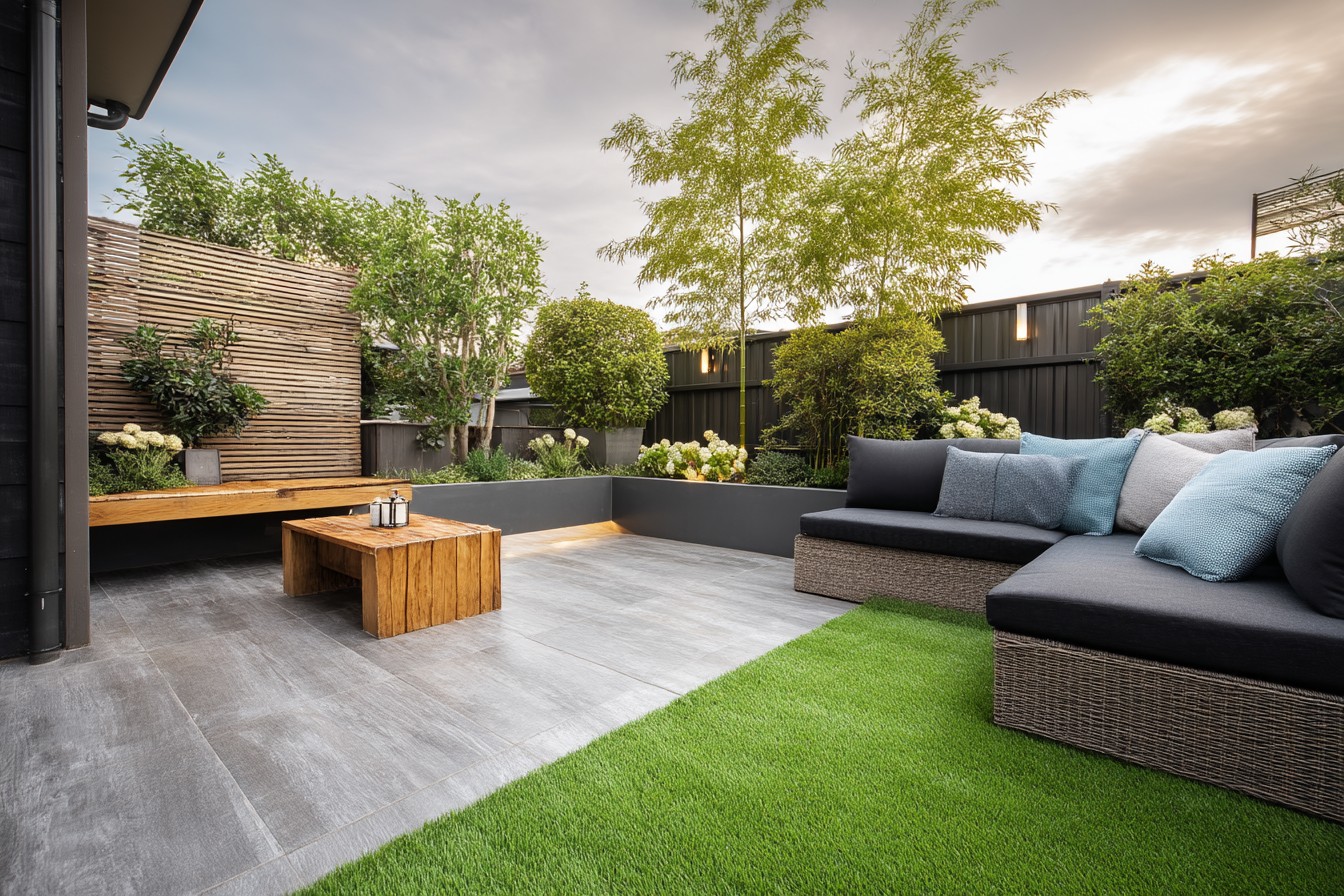
Our solution incorporated dual-purpose storage elements that provide both practical capacity and additional functionality – bench seating with waterproof internal compartments, side tables with concealed storage space, even traditional garden storage disguised within decorative planters. This distributed approach ensures necessary items remain immediately available without dedicated trips inside, substantially increasing spontaneous patio use during marginal conditions when extra preparation requirements might otherwise discourage outdoor enjoyment.
Practical details like power provision fundamentally influence all-weather usability yet often receive inadequate attention during design phases. Properly installed external sockets with appropriate protection eliminate the extension cords and temporary solutions that make outdoor entertaining unnecessarily complicated during challenging conditions. For our patio, we installed multiple dedicated external circuits with proper RCD protection – some permanent for integrated lighting and heating, others accessible for occasional equipment like outdoor speakers, projectors, or cooking appliances.
This power infrastructure transforms possible activities beyond basic outdoor dining, enabling everything from work-from-garden days with laptop charging to evening movie projections against blank walls. These expanded use possibilities substantially increase overall space utilization throughout the year rather than limiting outdoor areas to traditional functions typically concentrated in better weather periods. The modest additional investment during construction phases delivers disproportionate functional benefits compared to retrofitting power solutions after completion.
For clients with larger budgets or particularly challenging sites, hybrid indoor-outdoor structures provide the ultimate all-weather solution while maintaining genuine garden connection. Modern orangeries, contemporary garden rooms with substantial glazing, or traditional conservatories with proper climate control offer year-round usability regardless of weather conditions while preserving strong visual and often physical connections to surrounding outdoor space.
These structures deserve careful technical consideration beyond their architectural appeal, particularly regarding temperature control throughout different seasons. Traditional conservatories notoriously create uncomfortably hot spaces during summer and excessively cold environments during winter unless specified with appropriate glazing, ventilation, and often supplementary heating/cooling systems. Modern equivalents with high-performance glass, proper ventilation design, and sometimes integrated climate control provide genuinely year-round functionality rather than merely extending seasonal usability.
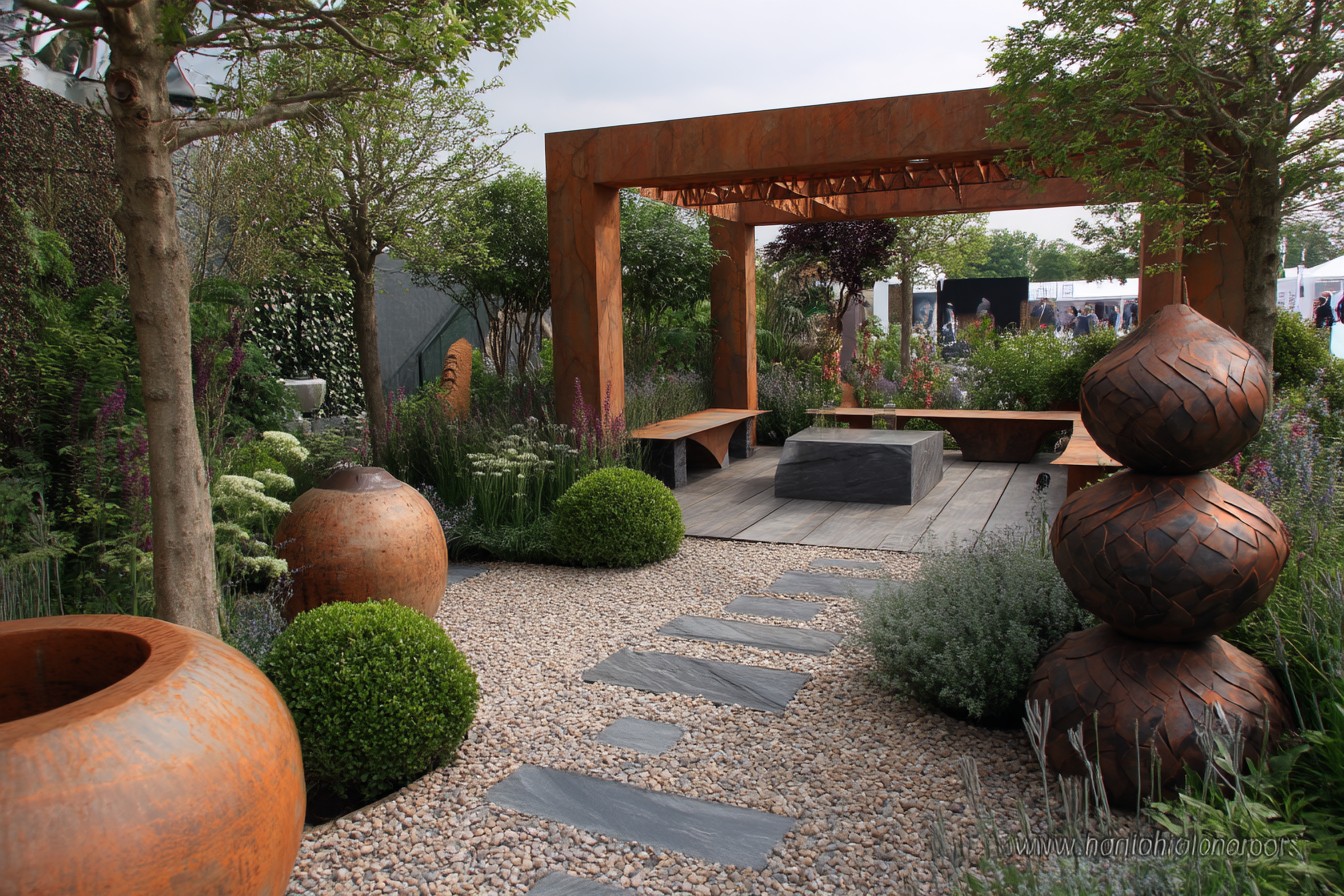
For more modest budgets, strategic positioning often delivers disproportionate benefits compared to elaborate structures or systems. Careful analysis of specific site characteristics – microclimate variations, prevailing wind directions, sun patterns throughout the year, natural shelter from buildings or mature vegetation – allows optimization of even simple patio arrangements for maximum usability. Some of our most successful projects have involved relocating proposed patios to positions offering natural protection rather than traditional garden-center placements that align with conventional aesthetic expectations but deliver poor functional performance.
This position-first approach extends to internal garden arrangements as well as overall placement. For a recent project with limited space for covered structures, we created what amounted to an outdoor room using strategic planting of appropriate species forming natural windbreaks and partial canopy coverage. The resulting space provides noticeable moderation of typical weather impacts without requiring substantial construction, though it demands more patience as planted elements mature into their functional roles.
Seasonal adaptability represents another crucial characteristic of truly successful all-weather designs. Rather than creating fixed environments optimized for specific conditions, the most effective arrangements incorporate adjustable elements that respond to changing requirements throughout the year. Retractable canopies, removable side panels, adjustable ventilation systems, and modifiable layouts allow spaces to adapt to both weather variation and different functional requirements across seasons.
Our own patio incorporates several such adaptable features, including a pergola section with adjustable fabric canopy that provides additional shade during rare intensely sunny periods but can be retracted to maximize light penetration during typically overcast days. Similarly, removable glass windbreaks offer additional protection during colder months while maintaining openness during summer evenings. These adaptable elements substantially extend functional seasons beyond what fixed designs typically achieve regardless of their specific configuration.
Water management beyond basic drainage offers additional opportunities for enhancing all-weather functionality. For properties with appropriate space and suitable rainfall patterns, integrated rainwater collection systems can transform precipitation from problem to resource, particularly valuable during increasingly common hosepipe restrictions. Our modest system captures runoff from the covered patio section, storing it in concealed tanks that supply garden irrigation during drier periods – a practical sustainability measure that also simplifies maintenance requirements.

For clients with more substantial budgets, advanced options like warm-water underfloor heating in external areas can transform winter usability beyond what conventional overhead heaters typically achieve. While representing significant investment during construction phases, these systems provide remarkably efficient operation compared to heating air in semi-exposed environments. They’re particularly effective for dining areas where seated guests benefit from gentle radiant warmth rising from below rather than directional heat from above that often creates uncomfortable hot spots and cold zones.
Material performance in consistently damp conditions deserves particular attention beyond initial appearance and cost considerations. Many conventional patio materials develop problematic characteristics when regularly exposed to British weather patterns – natural stone can become dangerously slippery, certain timbers deteriorate rapidly despite treatment, some manufactured products discolor unevenly or develop unsightly organic growth. Our material selections prioritize long-term performance in realistic conditions rather than perfect appearance in showroom environments or Mediterranean climates.
This performance focus extends to all elements within outdoor spaces, not merely flooring surfaces. Furniture frames, fabric specifications, lighting fixtures, and even seemingly minor details like screw or fixing materials all require appropriate selection for British conditions rather than generic outdoor ratings that often assume drier or more consistent climates. The most successful installations acknowledge the particularly challenging combination of frequent precipitation, moderate temperatures ideal for organic growth, and seasonal freeze-thaw cycles that characterize many UK regions.
For those creating their own all-weather patios, I’d recommend beginning with honest assessment of your actual outdoor living patterns rather than aspirational scenarios. Which activities do you genuinely value enough to justify weather-protected space? How frequently would you use outdoor areas if weather barriers were removed? What specific conditions typically prevent your garden enjoyment rather than generic “bad weather” assumptions? These specific insights typically reveal more targeted solutions than comprehensive coverage that often goes unused despite substantial investment.
Consider too the relationship between protection levels and authentic outdoor experience. Complete weather elimination essentially creates conservatory-like environments that lose much of what makes garden living appealing – the connection to nature, fresh air movement, seasonal awareness, and sensory variation that distinguish outdoor spaces from interior rooms. The most successful designs balance practical protection against genuine weather challenges while preserving the essential qualities that make outdoor living distinctively valuable rather than merely relocated indoor activities.
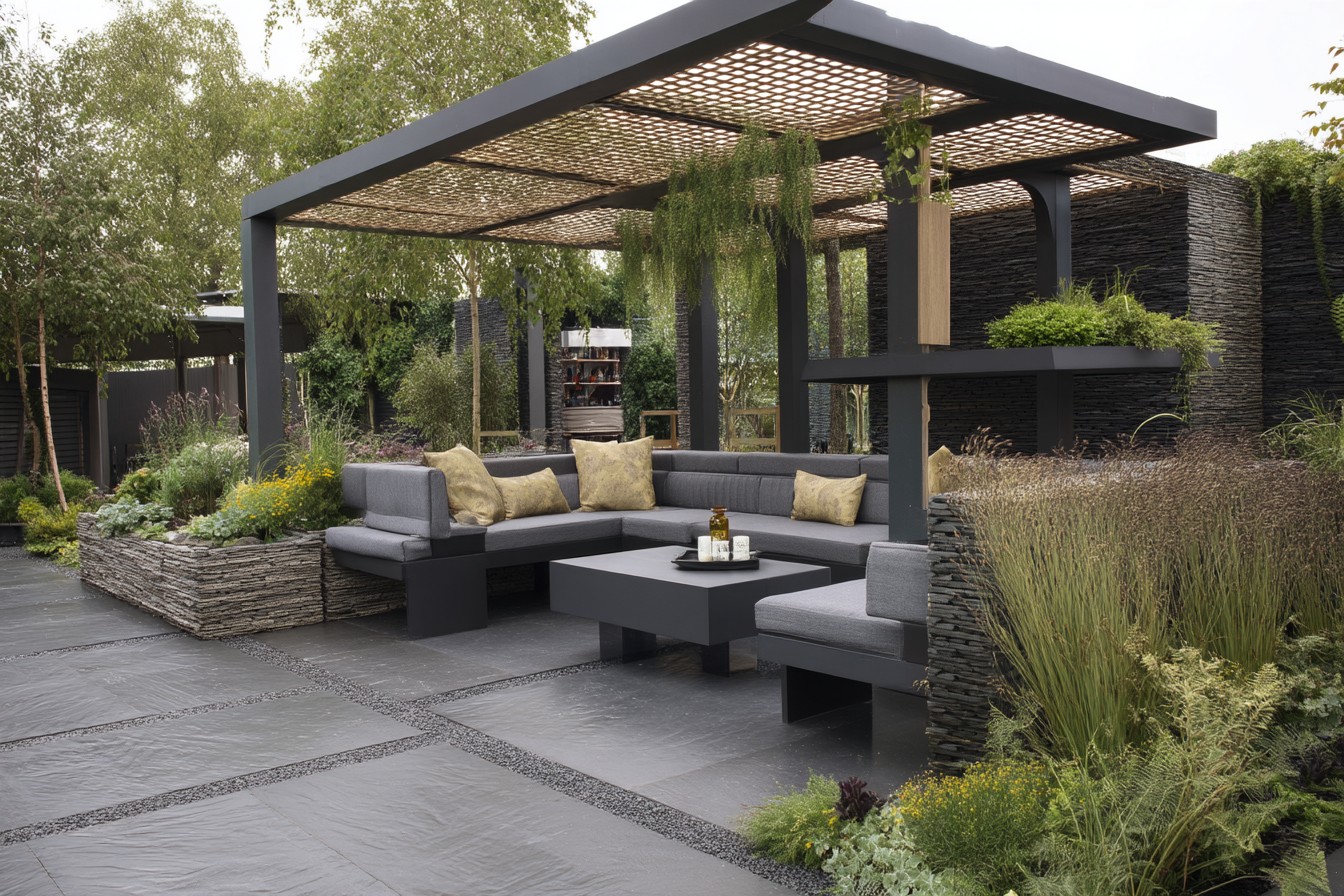
Budget constraints inevitably influence potential solutions, but even modest investments targeted at specific limiting factors typically deliver disproportionate improvements in usability. For clients with limited resources, I often recommend addressing the single weather element that most restricts their particular usage – sometimes overhead protection in particularly rainy regions, elsewhere vertical windbreaks in exposed locations, or targeted heating in areas where evening temperature drops prematurely end otherwise pleasant gatherings. These focused interventions often extend usable days substantially more effectively than partial implementation of comprehensive systems beyond available resources.
Our own patio continues evolving as climate patterns shift and our usage preferences develop. What began primarily as rain protection has gradually incorporated additional features addressing changing weather challenges – more substantial wind protection as storm patterns intensify, improved shade options during increasingly frequent heat episodes, enhanced drainage to manage the more intense rainfall events climate change brings to our region. This adaptability ensures continued functionality despite environmental shifts rather than declining performance as conditions change from historical patterns that informed initial design decisions.
The true measure of successful all-weather patios lies not in their photogenic qualities or alignment with design trends, but in how many additional days of genuine outdoor enjoyment they enable throughout the year. When brief dry spells between showers become genuinely usable rather than merely tantalizing glimpses of what might have been, when shoulder seasons extend usability from a few summer months to most of the year, when outdoor living becomes practical reality rather than perpetually deferred aspiration – these practical improvements in garden enjoyment represent the genuine value of thoughtfully designed all-weather spaces, regardless of their size or sophistication.
As typical British understatement, I’ll simply note that our patio usage has increased from approximately twenty days annually to well over two hundred – a transformation that has effectively added a room to our home for a fraction of the cost conventional extension would have required. The space hosts everything from morning coffee regardless of light drizzle to full dinner gatherings during more substantial rainfall, comfortable work-from-garden days that continue despite passing showers, and evening relaxation that doesn’t end with the first hint of precipitation. Not quite Mediterranean living perhaps, but a thoroughly practical compromise with the meteorological realities of northern England.